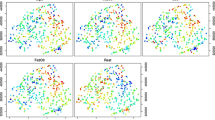Abstract
A recently discovered error in the part of the computer program WACALIB that implements maximum likelihood (ML) calibration has been discovered and corrected. The new version of WACALIB has been re-run with all the data-sets from which results based on the earlier version of WACALIB had been published. The new results suggest that ML regression and calibration perform as well or even better than weighted averaging (WA), at least when judged by the apparent root mean squared error. Further work involving cross-validation is required to evaluate more fully the relative performance of WA and ML approaches.
Similar content being viewed by others
References
Birks, H. J. B., 1995. Quantitative palaeoenvironmental reconstructions. In Maddy D. & J. S. Brew (eds), Statistical Modelling of Quaternary Science Data. Technical Guide 5. Quat. Res. Assoc., Cambridge, 161–254.
Birks, H. J. B., 1998. Numerical tools in palaeolimnology - Progress, potentialities, and problems. J. Paleolim. 20: 307–332.
Birks, H. J. B., J. M. Line, S. Juggins, A. C. Stevenson & C. J. F. ter Braak, 1990. Diatoms and pH reconstruction. Phil. Trans. R. Soc., Lond. B 327: 263–278.
Cumming, B. F., J. P. Smol & H. J. B. Birks, 1992. Scaled chrysophytes (Chrysophyceae and Synurophyceae) from Adirondack drainage lakes and their relationship to environmental variables. J. Phycol. 28: 162–178.
Gallant, A. R., 1975. Nonlinear regression. Am. Statist. 29: 73–81.
Imbrie, J. & N. G. Kipp, 1971. A new micropaleontological method for quantitative paleoclimatology: application to a late Pleistocene Carribean core. In Turekian K. K. (ed), The Late Cenozoic Glacial Ages. Yale University Press, New Haven: 71–181.
Juggins, S., 1992. Diatoms in the Thames Estuary, England: Ecology, Palaeoecology, and Salinity Transfer Function. Bibliothec. Diatomolog. 25, 216 pp.
Juggins, S., 1993. GLR - a program for Gaussian logit regression. Unpublished C++ program.
Kingston, J. C. & H. J. B. Birks, 1990. Dissolved organic carbon reconstructions from diatom assemblages in PIRLA project lakes, North America. Phil. Trans. r. Soc., Lond. B 327: 279–288.
Line, J. M. & H. J. B. Birks, 1990. WACALIB version 2.1 - a computer program to reconstruct environmental variables from fossil assemblages by weighted averaging. J. Paleolim. 3: 170–173.
Line, J. M., C. J. F. ter Braak & H. J. B. Birks, 1994. WACALIB version 3.3 - a computer program to reconstruct environmental variables from fossil assemblages by weighted averaging and to derive sample-specific errors of prediction. J. Paleolim. 10: 147–152.
Oksanen, J., E. Lä ä rä , P. Huttunen & J. Merilä inen, 1988. Estimation of pH optima and tolerances of diatoms in lake sediments by the methods of weighted averaging, least squares and maximum likelihood, and their use for the prediction of lake acidity. J. Paleolim. 1: 39–49.
Oksanen, J., E. Lä ä rä , P. Huttunen & J. Merilä inen, 1990. Maximum likelihood prediction of lake acidity based on sedimented diatoms. J. Veg. Sci. 1: 49–56.
Olander, H., H. J. B. Birks, A. Korhola & T. Blom, 1999. An expanded calibration model for inferring lakewater and air temperatures from fossil chironomid assemblages in northern Fennoscandia. The Holocene 9: 279–294.
ter Braak, C. J. F., 1995. Non-linear methods for multivariate statistical calibration and their use in palaeoecology: a comparison of inverse (k-nearest neighbours, partial least squares and weighted averaging partial least squares) and classical approaches. Chemometrics and Intelligent Laboratory Systems 28: 165–180.
ter Braak, C. J. F. & H. van Dam, 1989. Inferring pH from diatoms: a comparison of old and new calibration methods. Hydrobiologia 178: 209–223.
ter Braak, C. J. F. & S. Juggins, 1993. Weighted averaging partial least squares regression (WA-PLS): an improved method for reconstructing environmental variables from species assemblages. Hydrobiologia 269/270: 485–502.
ter Braak, C. J. F., S. Juggins, H. J. B. Birks & H. van der Voet, 1993. Weighted averaging partial least squares regression (WAPLS): Definition and comparison with other methods for species-environment calibration. In Patil G. P. & C. R. Rao (eds), Multivariate Environmental Statistics, Elsevier Science Publishers, Amsterdam: 525–560.
ter Braak, C. J. F. & I. C. Prentice, 1988. A theory of gradient analysis. Adv. Ecol. Res. 18: 271317.
Author information
Authors and Affiliations
Rights and permissions
About this article
Cite this article
Birks, H. Maximum likelihood environmental calibration and the compute program WACALIB a correction. Journal of Paleolimnology 25, 111–115 (2001). https://doi.org/10.1023/A:1008152423742
Issue Date:
DOI: https://doi.org/10.1023/A:1008152423742




